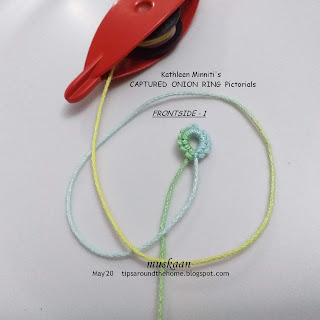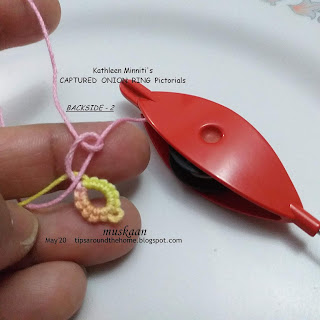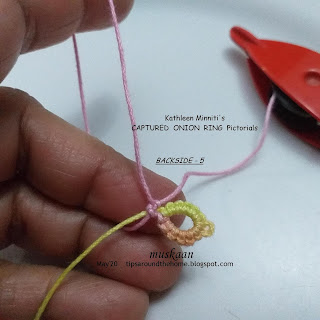Ninetta
has been posting a comprehensive study of Onion Rings – their construction and
variations – along with pictorials and tutorial links. A must-read for anybody
wishing to learn, explore, or improve. A sumptuous dish!
My
guess is that Marilyn followed one of those links to my blog and left a comment for help with captured onion ring.
Ever
since I tried it here for the first time, I have been hooked to this method and
have used it consistently with good effect. I think this is a good excuse, and
opportunity, to present a stepwise tutorial.
Captured
Onion Rings
Kathleen Minniti's method
BACKGROUND :
Captured
Onion Rings are a pair of concentrically placed True rings. These true rings can be tatted with the same shuttle, or with different shuttles for a
2-colour version.
Aurora Lozada first shared her Perfect Onion Ring method (pdf) in 2014 with the Online Tatting Class. She captures the inner ring between the core and working thread After making 1ds.
Thus the inner ring is captured Between adjacent stitches of the outer ring. After
closing the outer ring, the emerging thread is offset by the 1st ds.
Kathleen
Minniti improvised Aurora
I
can now understand Aurora
Captured
Onion Ring Pictorial - FRONTSIDE
I
have used a single shuttle for the pictorial.
Inner
ring : 6 – 6.
Outer
ring : 10 + 10.
1.
Tat inner ring. Close ring and loop the thread around to start outer ring.
2.
Hold in pinch.
3.
Start 1st half stitch – under ….
4.
…..over
5.
1st half-stitch seen clearly after the flip, but do not snug.
6.
Pass the inner ring through the open leg of this 1st half-stitch.
Follow the core thread (just as in tatting over tail).
7.
Bring the leg to the base of the inner ring by wiggling your left index finger, and
8. snug tight. Make sure the stitch is as close to the base as possible, and that
the core thread slides freely.
9.
Make the 2nd half-stitch (over-under) and
10.
snug normally. 1st ds complete.
11.
Tat around the inner ring, joining to the picot. I used the ball thread or onion ring join.
12.
Close the outer ring normally. A pair of concentric or onion rings is ready.
In
the above ConcentriCITY snowflake, there are 3 concentric rings where the outermost
is a chain or mock ring. To bring the shuttles in position, the middle ring is
worked backside. This is what Marilyn was referring to. Hence here are
a few pics showing the backside working of the captured onion ring.
Note:
In directional or frontside/backside tatting, the sequence of half-stitches in
a ds is reversed (hence called RODS – reverse order of double stitch) working 2nd
half before 1st half-stitch.
Captured
Onion Ring Pictorial - Backside
In this pictorial, both rings are worked backside, but this is not compulsory.
1.
Inner ring worked backside. Loop the thread around to start outer ring, and
pass shuttle over-under to make the 2nd half-stitch.
7. This is how it looks from the front. (There is some inadvertent space left at the base - the ring should've been pulled close more tightly to avoid that pink line).
Note : This method is so basic that it can be used even for chains/ mock rings, etc. , either in onion rings or in other situations.
Hope this answers your question, Marilyn?
Many many thanks to Aurora & Kathleen :-)
My onion rings have certainly improved!





















Gosh, who knew? It certainly looks neat.
ReplyDeleteFantastic onion ring tutorials! The results look so perfect.
ReplyDeleteFantastic post! You are so clear and concise! Thank you, thank you....
ReplyDeleteNow to muster up the courage to tat those rings. It will be without tears thanks to you, Aurora, Ninetta and all my tatting friends!
Wonderful tutorials!
ReplyDeleteStephanieW
💕 Thank you! Very clear pictures 🥰 That is the missing link (sorry for the word pun 😜)!!!
ReplyDeleteI will have to try this with the next onion ring attempt!! ;)
ReplyDeleteLove the colors!!!! :)
Very nicely presented! Now I want to practice onion rings!
ReplyDeleteI am thrilled that you enjoyed this pictorial and method! Thank you all very much for your lovely comments :-)))
ReplyDeleteDziękuję za instrukcję, pewnie w jakiejś pracy wykorzystam.
ReplyDeletePozdrawiam ciepło.
Have fun, splocik 😍
DeleteThank you very much! Your instructions are always so clear with great pictures. Your site is my homepage!
ReplyDeleteDo you also use this method when the outer ring is a chain? A chain is needed for thrown rings around the outer ring.
ReplyDeleteGlad you like the pictorial & my blog, Marilyn 💜
DeleteYes, I use this with chains and mock rings - forgot to mention in this post. Give it a go and enjoy 😍
Thank you, again for this! I use this method all the time now and have successfully completed a project with 30 Onion Rings. ❤
DeleteWow, this is such a Huge endorsement for Kathleen's method! Thank you for the feedback, Marilyn - it is Always appreciated. :-)))
DeleteI fell in love with Onion Rings since almost my first ring. The simplicity of that complex shape, perhaps the only complex shape in tatting, grabbed my attention years ago and happily, more and more tatters are working on/with them, developing new techs and designs for it. Thanks for sharing yours.
ReplyDeleteAurora
We learn from each other, Aurora! Thank you so very much :-) I enjoy the diversity it provides, besides it's visual beauty.
DeleteAn other interesting post, I love doing onion rings and I have done this method many times before. great tutorial
ReplyDeleteThanks, Margaret :-)
DeleteThis is fabulous and that thread is very pretty too. I still think you could make a tatting encyclopedia it would be big but worth having
ReplyDeleteLOL, Carollyn, in the nano tech age, we really shouldn't be talking about tomes ;-P Thanks for the thumbs-up, though!
DeleteI have loved and researched onion rings for years - true-ring outer layer and mock-ring outer layer. This is the neatest technique for aligning the beginnings of both rings.
ReplyDeleteThere are different joins that have been called 'onion ring join'. Which one did you use here, muskaan?
I agree, Judith!
DeleteI used the ball thread join - http://www.bellaonline.com/articles/art39226.asp, and I mused a down loop for frontside.
Thank you. That would be Deb Arnold's slope-and-roll join.
ReplyDeleteHave you tried Aurora's method with just a half-stitch at the start? I have been using this technique for quite some time. That would approximate Kathleen's motion, but with less bulk.
Any idea which join was published first, Judith? Thanks. 🌹
DeleteAs for the onion ring methods, please read the 'Background' segment in my post above.
Deb Arnold's join has been around since 2003. The bellaonline 'ball thread' one appears to be the same join.
ReplyDeleteI had read your intro, but am just suggesting starting Aurora's method with a half-stitch so that the inner ring lies between two half-stitches, rather than two double stitches. This would bring the start of the two rings as close as in Kathleen's method, but with slightly less bulk. Also, post the shuttle before closing the inner ring. ??
I just posted my trials and comparison, Judith, and your variation definitely looks much better though I find working Kathleen's method easier (or perhaps it is merely that I have more practice with it... time will tell). Thank you!
DeleteYou're welcome, muskaan. I have been using it off and on for years (as probably have other tatters). Which just goes to show that there is nothing really new under the sun. :-)
DeleteI agree, Judith :-) Each generation thinks it has invented something new and therein lies the thrill of achievement ;-D
DeleteThank you once again.
Perfect looing Onion Rings. Very clever!
ReplyDeleteSo glad you approve, Master A 🌹💗🌹
DeleteThis comment has been removed by the author.
ReplyDelete